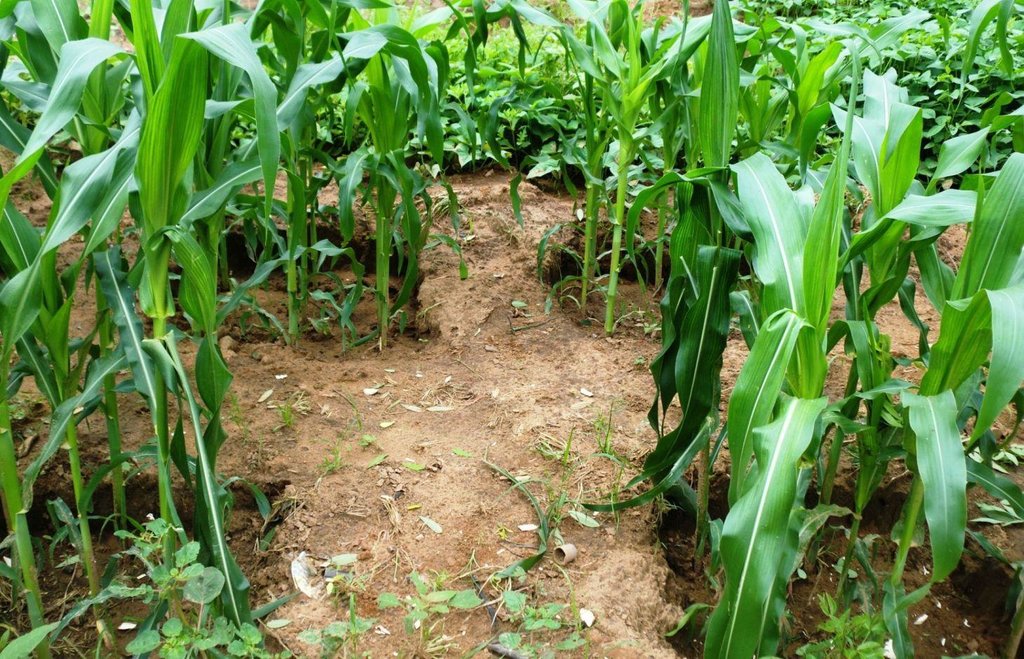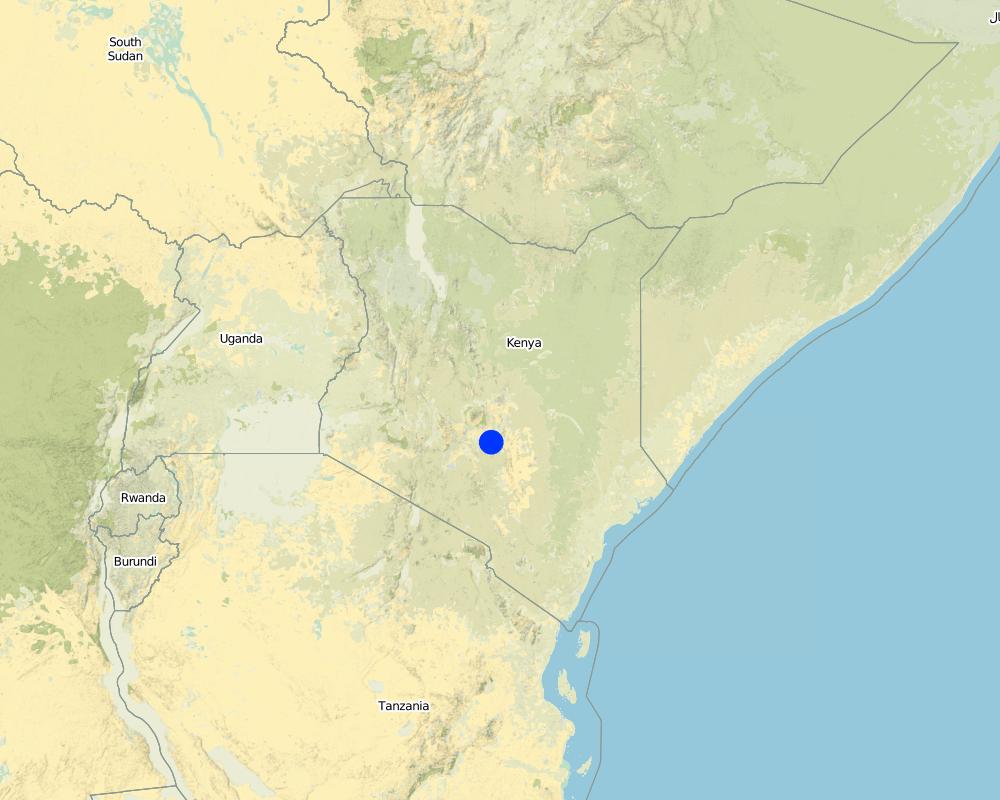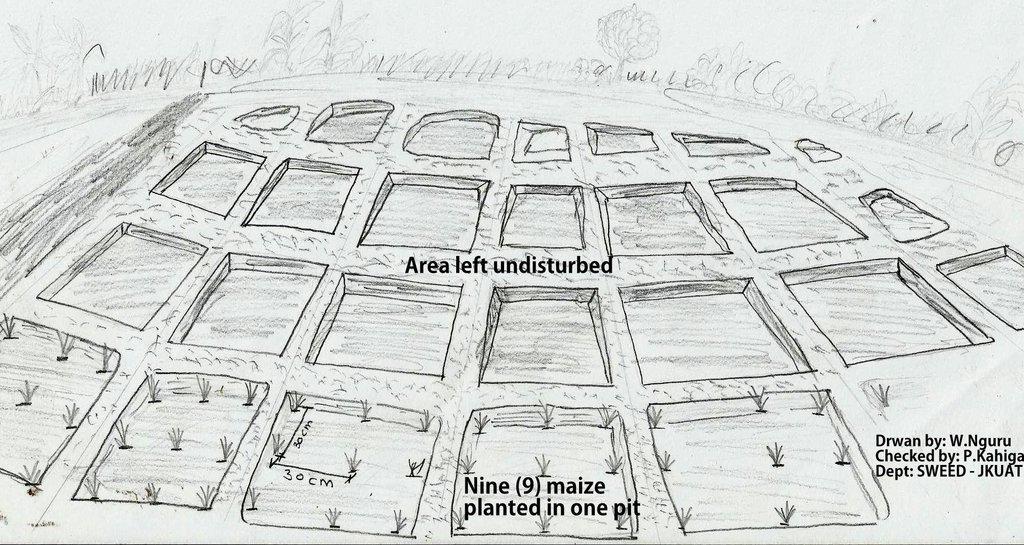Nine Maize Pits [Kenya]
- Creation:
- Update:
- Compiler: Paul Kahiga
- Editor: –
- Reviewer: Fabian Ottiger
Maize Pits
technologies_1676 - Kenya
View sections
Expand all Collapse all1. General information
1.2 Contact details of resource persons and institutions involved in the assessment and documentation of the Technology
SLM specialist:
Gathenya Mwangi
Jomo Kenyatta University of Agriculture and Technology
P.O.Box, 62000-00200, Nairobi, Juja
Kenya
SLM specialist:
Home Patrick
Jomo Kenyatta University of Agriculture and Technology
P.O.Box, 62000-00200, Nairobi, Juja
Kenya
SLM specialist:
Chege Timothy
Jomo Kenyatta University of Agriculture and Technology
P.O.Box, 62000-00200, Nairobi, Juja
Kenya
SLM specialist:
Abamba Omwange
Jomo Kenyatta University of Agriculture and Technology
P.O.Box, 62000-00200, Nairobi, Juja
Kenya
SLM specialist:
Baobab Kimengich
Jomo Kenyatta University of Agriculture and Technology
P.O.Box, 62000-00200, Nairobi, Juja
Kenya
SLM specialist:
Wamuongo Jane
+254 729 054547
Kenya Agricultural Research Institute
Nairobi
Kenya
SLM specialist:
Karanja Andrew
+254 729 054547
Kenya Agricultural Research Institute
Nairobi
Kenya
SLM specialist:
Namirembe Sara
+254 20 7224000
World Agroforestry Centre (ICRAF)
United Nations Avenue, P. O. Box 30677, Nairobi, Kenya
Kenya
Name of the institution(s) which facilitated the documentation/ evaluation of the Technology (if relevant)
International Centre for Research in Agroforestry (ICRAF) - KenyaName of the institution(s) which facilitated the documentation/ evaluation of the Technology (if relevant)
KARI Headquarters (KARI Headquarters) - KenyaName of the institution(s) which facilitated the documentation/ evaluation of the Technology (if relevant)
Jomo Kenyatta University (Jomo Kenyatta University) - Kenya1.3 Conditions regarding the use of data documented through WOCAT
When were the data compiled (in the field)?
19/09/2012
The compiler and key resource person(s) accept the conditions regarding the use of data documented through WOCAT:
Yes
1.4 Declaration on sustainability of the described Technology
Is the Technology described here problematic with regard to land degradation, so that it cannot be declared a sustainable land management technology?
No
2. Description of the SLM Technology
2.1 Short description of the Technology
Definition of the Technology:
The nine maize pits is a type of SLM technology whereby, a planting pits measuring (2*2*2) feet are dug along a contour and maize planted in the pit at a spacing of (30*30) cm. The top soil is mixed with FYM and the spaces in between are left un-ploughed.
2.2 Detailed description of the Technology
Description:
Maize pits commonly referred as zai is a traditional land rehabilitation technology “invented” to rehabilitate degraded dry lands and to restore soil fertility to the benefit of farmers living there.They are made on land which is not very permeable so that runoff can be collected. Improvements in the traditional pits by the addition of organic matter (compost) have resulted in dramatic improvements in yield. The planting pits are suitable for semi-arid area like the lower Mbeere District to enable crops to survive dry spells. They are used on a wide variety soil types but most suitable on silt and clay soils where runoff can be generated due to limited permeability.
Purpose of the Technology: Apart from establishment of a nine maize crop stand in one pit, the technology assists in harvesting rain water, conserving the moisture, managing of soil fertility and controlling of weed development. Use of this technique in Mbeere South District have produced higher grain yields, particularly on highly degraded sandy soils. They offers a good potential to both increase the livelihood of the rural population and at the same time, combat desertification.
Establishment / maintenance activities and inputs: The process is started in dry season of the year. Holes of 2ft by 2ft and 2ft deep are dug out. Remove the top soil and put it on the uphill side. Remove the subsoil and place it down hill to form a continuous bund from end to end of each row. The top soil is returned into the pit and mixed with animal manure at the rate of 1 debe per hole. Plant 9 maize seeds on the pit at a spacing of 1foot. The compost can be made from rotted cow/sheep dung, leaves, and ashes from wood-fueled stoves.
Natural / human environment: These maize pits are usually constructed on abandoned or unused ground. Thus, crop yields resulting from this practice bring a benefit of 100%.
2.3 Photos of the Technology
2.5 Country/ region/ locations where the Technology has been applied and which are covered by this assessment
Country:
Kenya
Region/ State/ Province:
Eastern Province
Further specification of location:
Mbere South District
Map
×2.6 Date of implementation
If precise year is not known, indicate approximate date:
- 10-50 years ago
2.7 Introduction of the Technology
Specify how the Technology was introduced:
- through land users' innovation
3. Classification of the SLM Technology
3.1 Main purpose(s) of the Technology
- improve production
- reduce, prevent, restore land degradation
- adapt to climate change/ extremes and its impacts
- create beneficial economic impact
3.2 Current land use type(s) where the Technology is applied

Cropland
- Annual cropping
Main crops (cash and food crops):
Major cash crop: Green grams
Major food crop: Green grams / Maize
Comments:
Major land use problems (compiler’s opinion): Crop water deficiency due to low soil moisture content
Major land use problems (land users’ perception): Inadequate water for the crop
Future (final) land use (after implementation of SLM Technology): Cropland: Ca: Annual cropping
If land use has changed due to the implementation of the Technology, indicate land use before implementation of the Technology:
Cropland: Ct: Tree and shrub cropping
3.3 Further information about land use
Water supply for the land on which the Technology is applied:
- rainfed
Comments:
Water supply: Also post-flooding
Number of growing seasons per year:
- 1
Specify:
Longest growing period in days: 90, Longest growing period from month to month: March to May
3.4 SLM group to which the Technology belongs
- minimal soil disturbance
- integrated soil fertility management
- water harvesting
3.5 Spread of the Technology
Specify the spread of the Technology:
- evenly spread over an area
If the Technology is evenly spread over an area, indicate approximate area covered:
- < 0.1 km2 (10 ha)
Comments:
Practiced by many farmers with the assistance of an Agriculture extension officer from the ministry of Agriculture.
3.6 SLM measures comprising the Technology

structural measures
- S2: Bunds, banks
3.7 Main types of land degradation addressed by the Technology

water degradation
- Ha: aridification
Comments:
Main causes of degradation: soil management, Heavy / extreme rainfall (intensity/amounts), poverty / wealth, labour availability
Secondary causes of degradation: deforestation / removal of natural vegetation (incl. forest fires)
3.8 Prevention, reduction, or restoration of land degradation
Specify the goal of the Technology with regard to land degradation:
- prevent land degradation
- restore/ rehabilitate severely degraded land
4. Technical specifications, implementation activities, inputs, and costs
4.1 Technical drawing of the Technology
4.2 Technical specifications/ explanations of technical drawing
The technical drawing on the right side shows a representation of how the nine maize pits are prepared. The top soil is put aside and mixed with FYM or other organic matter. The area in between the pits is left undisturbed.
Location: Mbeere South District. Eastern
Date: 19/09/2012
Main technical functions: control of raindrop splash, water spreading, sediment retention / trapping, sediment harvesting
Secondary technical functions: control of dispersed runoff: retain / trap, control of concentrated runoff: retain / trap
Retention/infiltration ditch/pit, sediment/sand trap
Vertical interval between structures (m): 0.2
Spacing between structures (m): 0.3
Depth of ditches/pits/dams (m): 0.2
Width of ditches/pits/dams (m): 0.3
Length of ditches/pits/dams (m): 0.3
4.3 General information regarding the calculation of inputs and costs
other/ national currency (specify):
KSh
Indicate exchange rate from USD to local currency (if relevant): 1 USD =:
100.0
Indicate average wage cost of hired labour per day:
4.00
4.4 Establishment activities
| Activity | Type of measure | Timing | |
|---|---|---|---|
| 1. | Land clearing | Structural | Before onset of rainfall |
| 2. | Digging of pits | Structural | Before onste of rainfall |
| 3. | Buying of seed maize | Structural | before onset of rains |
| 4. | Planting of seed maize | Structural | just before onset of rain |
4.5 Costs and inputs needed for establishment
| Specify input | Unit | Quantity | Costs per Unit | Total costs per input | % of costs borne by land users | |
|---|---|---|---|---|---|---|
| Labour | Labour | ha | 1.0 | 24.0 | 24.0 | 100.0 |
| Equipment | Tools | ha | 1.0 | 15.0 | 15.0 | 100.0 |
| Plant material | Seeds | ha | 1.0 | 12.0 | 12.0 | 100.0 |
| Fertilizers and biocides | Manure (FYM) | ha | 1.0 | 50.0 | 50.0 | 100.0 |
| Total costs for establishment of the Technology | 101.0 | |||||
Comments:
Duration of establishment phase: 1 month(s)
4.6 Maintenance/ recurrent activities
| Activity | Type of measure | Timing/ frequency | |
|---|---|---|---|
| 1. | Weeding | Structural | after 2 months |
4.7 Costs and inputs needed for maintenance/ recurrent activities (per year)
| Specify input | Unit | Quantity | Costs per Unit | Total costs per input | % of costs borne by land users | |
|---|---|---|---|---|---|---|
| Labour | Labour (weeding) | ha | 1.0 | 24.0 | 24.0 | 100.0 |
| Equipment | Tools | ha | 1.0 | 15.0 | 15.0 | 100.0 |
| Total costs for maintenance of the Technology | 39.0 | |||||
4.8 Most important factors affecting the costs
Describe the most determinate factors affecting the costs:
It requires high intensity labour due to manual construction.
5. Natural and human environment
5.1 Climate
Annual rainfall
- < 250 mm
- 251-500 mm
- 501-750 mm
- 751-1,000 mm
- 1,001-1,500 mm
- 1,501-2,000 mm
- 2,001-3,000 mm
- 3,001-4,000 mm
- > 4,000 mm
Agro-climatic zone
- semi-arid
Thermal climate class: tropics
5.2 Topography
Slopes on average:
- flat (0-2%)
- gentle (3-5%)
- moderate (6-10%)
- rolling (11-15%)
- hilly (16-30%)
- steep (31-60%)
- very steep (>60%)
Landforms:
- plateau/plains
- ridges
- mountain slopes
- hill slopes
- footslopes
- valley floors
Altitudinal zone:
- 0-100 m a.s.l.
- 101-500 m a.s.l.
- 501-1,000 m a.s.l.
- 1,001-1,500 m a.s.l.
- 1,501-2,000 m a.s.l.
- 2,001-2,500 m a.s.l.
- 2,501-3,000 m a.s.l.
- 3,001-4,000 m a.s.l.
- > 4,000 m a.s.l.
5.3 Soils
Soil depth on average:
- very shallow (0-20 cm)
- shallow (21-50 cm)
- moderately deep (51-80 cm)
- deep (81-120 cm)
- very deep (> 120 cm)
Soil texture (topsoil):
- medium (loamy, silty)
Topsoil organic matter:
- medium (1-3%)
If available, attach full soil description or specify the available information, e.g. soil type, soil PH/ acidity, Cation Exchange Capacity, nitrogen, salinity etc.
Soil fertility: High
Soil drainage/infiltration: Good
Soil water storage capacity: High
5.4 Water availability and quality
Ground water table:
5-50 m
Availability of surface water:
medium
Water quality (untreated):
poor drinking water (treatment required)
5.5 Biodiversity
Species diversity:
- medium
5.6 Characteristics of land users applying the Technology
Market orientation of production system:
- mixed (subsistence/ commercial
Relative level of wealth:
- average
Individuals or groups:
- individual/ household
Level of mechanization:
- manual work
Gender:
- women
Indicate other relevant characteristics of the land users:
Land users applying the Technology are mainly common / average land users
Population density: 10-50 persons/km2
5.7 Average area of land owned or leased by land users applying the Technology
- < 0.5 ha
- 0.5-1 ha
- 1-2 ha
- 2-5 ha
- 5-15 ha
- 15-50 ha
- 50-100 ha
- 100-500 ha
- 500-1,000 ha
- 1,000-10,000 ha
- > 10,000 ha
Is this considered small-, medium- or large-scale (referring to local context)?
- small-scale
5.8 Land ownership, land use rights, and water use rights
Land ownership:
- individual, not titled
Land use rights:
- individual
Water use rights:
- individual
5.9 Access to services and infrastructure
health:
- poor
- moderate
- good
markets:
- poor
- moderate
- good
6. Impacts and concluding statements
6.1 On-site impacts the Technology has shown
Socio-economic impacts
Production
crop production
risk of production failure
land management
Comments/ specify:
Machinery
Income and costs
farm income
workload
Comments/ specify:
High manpower to dig the pits
Socio-cultural impacts
food security/ self-sufficiency
SLM/ land degradation knowledge
Food security and a source of income generation at household level
Ecological impacts
Water cycle/ runoff
harvesting/ collection of water
evaporation
Soil
soil moisture
6.2 Off-site impacts the Technology has shown
damage on neighbours' fields
damage on public/ private infrastructure
6.3 Exposure and sensitivity of the Technology to gradual climate change and climate-related extremes/ disasters (as perceived by land users)
Gradual climate change
Gradual climate change
| Season | Type of climatic change/ extreme | How does the Technology cope with it? | |
|---|---|---|---|
| annual temperature | increase | well |
Climate-related extremes (disasters)
Climatological disasters
| How does the Technology cope with it? | |
|---|---|
| drought | well |
Comments:
Increase the depth of the pit for high water retention to enable drought tolerance
6.4 Cost-benefit analysis
How do the benefits compare with the establishment costs (from land users’ perspective)?
Short-term returns:
positive
Long-term returns:
positive
How do the benefits compare with the maintenance/ recurrent costs (from land users' perspective)?
Short-term returns:
positive
Long-term returns:
positive
6.5 Adoption of the Technology
Of all those who have adopted the Technology, how many have did so spontaneously, i.e. without receiving any material incentives/ payments?
- 90-100%
Comments:
100% of land user families have adopted the Technology without any external material support
There is a moderate trend towards spontaneous adoption of the Technology
6.7 Strengths/ advantages/ opportunities of the Technology
| Strengths/ advantages/ opportunities in the land user’s view |
|---|
| Prevention of soil erosion. |
| It is a water harvesting technology. |
| Strengths/ advantages/ opportunities in the compiler’s or other key resource person’s view |
|---|
| Food security. |
| Prevention of excessive evaporation. |
| Income generation at household level. |
| Improves ground water recharge. |
6.8 Weaknesses/ disadvantages/ risks of the Technology and ways of overcoming them
| Weaknesses/ disadvantages/ risks in the land user’s view | How can they be overcome? |
|---|---|
| Encourages pests to stay in the pits |
| Weaknesses/ disadvantages/ risks in the compiler’s or other key resource person’s view | How can they be overcome? |
|---|---|
| Labour intensive (construction & maintenance) | |
| In wet seasons, they can be prone to water logging | |
| Prevents machinery movement in the farms |
7. References and links
7.1 Methods/ sources of information
- field visits, field surveys
- interviews with land users
Links and modules
Expand all Collapse allLinks
No links
Modules
No modules






